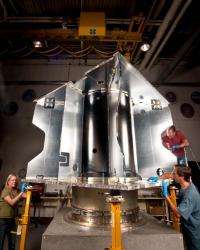MAVEN mission primary structure complete

NASA's Mars Atmosphere and Volatile EvolutioN (MAVEN) mission has reached a new milestone. Lockheed Martin has completed building the primary structure of the MAVEN spacecraft at its Space Systems Company facility near Denver.
"It's always a significant milestone when the project moves from a paper design to real hardware and software," said Guy Beutelschies, MAVEN program manager at Lockheed Martin Space Systems Company. "Seeing the core structure really reinforces the fact that MAVEN is no longer just a set of ideas that scientists and engineers have come up with, it is starting to become a spacecraft."
In mid October, the structure will be moved to Lockheed Martin's Structures Test Lab and undergo static load testing, which simulates and tests the many dynamic loads the spacecraft will experience during launch.
Despite the primary structure's light weight, it's designed to support the entire spacecraft mass during the launch, which applies an equivalent axial force at the launch vehicle interface of approximately 61,000 pounds when including accelerations up to 6 Gs. After completion of the static tests, the structure will be moved into a clean room to start propulsion subsystem integration. The Assembly, Test and Launch Operations (ATLO) phase begins July 2012.
"There's still a lot of work to go before we have the complete spacecraft, but this is a major step in getting us to the launch pad in two years," said Bruce Jakosky, MAVEN principal investigator from the Laboratory for Atmospheric and Space Physics at the University of Colorado. "All of the team's hard work now will pay off when we get to Mars and see the science results."
The goal of MAVEN is to determine the role that loss of atmospheric gas to space played in changing the Martian climate through time. MAVEN will determine how much of the Martian atmosphere has been lost over time by measuring the current rate of escape to space and gathering enough information about the relevant processes to allow extrapolation backward in time.
NASA Goddard Space Flight Center in Greenbelt, Md. manages the project and will also build some of the instruments for the mission. In addition to the principal investigator coming from CU-LASP, the university will provide science operations, build instruments, and lead education/public outreach. Lockheed Martin of Littleton, Colo., is building the spacecraft and will perform mission operations. The University of California-Berkeley Space Sciences Laboratory is also building instruments for the mission. NASA's Jet Propulsion Laboratory, Pasadena, Calif., will provide navigation support, the Deep Space Network, and the Electra telecommunications relay hardware and operations.
Provided by NASA's Goddard Space Flight Center





















